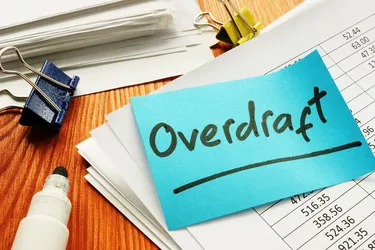
If you overdraw your Bank of America account, the fees vary based on what type of protection (or not) you've arranged. The bank doesn't require you to purchase or sign up for any extra overdraft Bank of America protection, but knowing what's available will help you decide whether or not you want to take extra steps to protect your account from mistakes you might make.
Read More: How to Login to Online Banking for Bank of America
Video of the Day
Video of the Day
What Are Overdrawn Accounts?
When you write a check, make a purchase or withdraw money from a financial account, you are drawing on the cash it contains. Think of drawing water from a well – you draw money from an account.
In its simplest terms, an overdrawn account is one in which you might have $100 and you write a $150 check or make a $125 purchase. You try to draw more money than you have in the account.
Depending on your bank or credit union, you will have a negative balance. That is usually followed by a penalty fee, an immediate request to add funds to your account and/or the account being frozen. In many cases, the financial institution won't honor a transaction that overdraws your account and your check will bounce or card transaction will be declined.
Read More: How to Unfreeze a Bank of America Account
Overdraft Bank of America Protection
Bank of America offers different levels of overdraft protections on its different accounts. According to Bank of America's website, even if you have overdraft protection, the bank might not cover an overdraft and you still might be charged a fee. In some cases, Bank of America will cover your overdraft and pay the balance for you.
For example, if you make a one-time debit card charge and don't have enough money in your account, Bank of America will decline the transaction and you won't pay a penalty fee. If you have a recurring payment set up with your account, such as a utility bill or monthly auto payment, Bank of America might honor the transaction and may charge you an overdraft fee.
You might be allowed to withdraw more money from an ATM if you agree to Bank of America's overdraft practices and fees while you're at the machine. If you write a check for more than you have in your account, Bank of America might pay the check and charge you a fee, or might not pay the check and charge you a fee. The Bank of America website does not specify when this will or won't happen.
Read More: How to Close a Bank of America Account Online
Bank of America Balance Connect
One way to avoid fees, penalties and having your account frozen after an overdraft is to sign up for Bank of America's Balance Connect option. If you have more than one Bank of America account, such as a savings and a checking account, you can link the accounts. If you overdraw your checking account, Bank of America will transfer money from your savings account to your checking account to allow your check to go through.
If you have more than two Bank of America accounts, you specify which accounts you want to be used for transfers in the order of your preference. You can link up to five accounts, but not a Bank of America Advantage SafeBalance Banking account.
There is no monthly fee for this service, but when you overdraw your account and a transfer is made, you might pay a fee. You can check your Personal Schedule of Fees at the Bank of America website.
Set Up Alerts
Depending on what type of accounts you have, you might be able to set up alerts that notify you when your account balance gets below a certain amount. This gives you the opportunity to avoid bouncing checks, missing auto payments or trying to make payments that won't go through. Once you receive your notification, you can decide whether to add more money to your account or hold off on a transaction, such as until after your next paycheck is direct-deposited into your account.